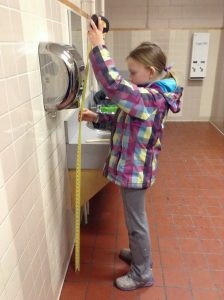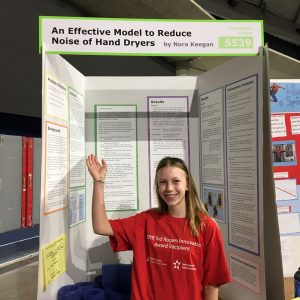In This Episode: Previous episodes have pointed out that children can indeed have Uncommon Sense. So much so, they can truly contribute to society. So this week, I’ll tell you about Nora Keegan. She’s 14, and has been doing something extraordinary for five years now.
074: “I’ve Learned to Never Give Up”
How to Subscribe and List of All Episodes
Show Notes
- Help Support Uncommon Sense — yes, $5 helps!
- If you want to understand better how sound pressures double, see Understanding the 3dB rule by “Noise Measurement Experts” who have been in the biz for a long time.
- Nora’s paper was published in the June 2020 issue of Paediatrics & Child Health.
- There are a few photos in the transcript below.
Transcript
Welcome to Uncommon Sense. I’m Randy Cassingham.
At 8 years old, Nora Keegan of Calgary, Alberta, Canada, noticed something that a lot of kids notice: hand dryers — the ones that blow air really hard over your hands — are really, really loud. So much so that she noticed her ears hurt when she was done with them. “I thought maybe the kids aren’t just being oversensitive,” she said later, “the hand dryers are being really loud.”
As she got to the ripe old age of 9, Nora’s young mind was putting some pieces together. Is something that loud harmful, especially for children? It’s not just because children’s hearing is more sensitive than adults’ hearing. Their arms are a lot shorter than adults’, so they have to stand closer to the machines. Plus, they’re mounted on the wall about four feet up, to make them convenient for adults, but still useable by children. That means kids old enough to wash by themselves, who are very commonly in the range of four feet tall, end up with the machine right in front of their heads.

You might recall that your ears are attached to your head. Same with kids!
So the machines are vertically right by their ears, and horizontally? Well, with their short arms, they’re close horizontally, too. And then there’s their sensitive hearing.
Enter Nora Keegan’s curious mind, driven by Uncommon Sense. “I decided to do a study,” she said, and “test it to see if they were dangerous to hearing.”
Well, how do you do that?
Sound pressure is typically measured in decibels, dB for short, which isn’t actually a loudness measure per se — the range doesn’t go from zero to 10, for instance (or even to 11 for you Spinal Tap fans). To confuse lay people even more, a sound pressure level of 20 dB isn’t double 10 dB.
Decibels are a measure of relative intensity starting at a baseline, and for sound pressure, that baseline is considered to be the lower threshold of human hearing — what a good young ear can barely discern. That has been measured at 20 micro-Pascals, which is about equivalent to hearing a mosquito flying three meters from your ear — nearly 10 feet. Older adults might not hear a mosquito until it gets about 3 inches from their ear. That level, 20 micro-Pascals, is commonly referred to as 20 decibels SPL (for Sound Pressure Level), or 20 dB for short.
Here’s the crazy thing about how all of this is measured. 20 dB is about the lowest level of sound that the best human ear can discern. If you double that sound pressure, the measurement isn’t 40 dB; you get to 23 dB — every 3 dB represents a doubling of the sound pressure. Double it again and you get to 26 dB. Since we’re starting with a flying mosquito at 3 meters, even doubling it twice is still pretty darned quiet. Double it again and you’re at 29 dB, which is around the sound of someone whispering into your ear.
Double it several more times to get to 60 dB, and you’re at the level of normal conversation.
Double it several more times to get to 90 dB, and you’re at the level of a typical gasoline-powered lawnmower. If you’ve seen professionals using lawnmowers, they wear hearing protection — earplugs or earmuffs — because being exposed to 90 dB for just one eight-hour work day will cause measurable hearing damage. As you may know, hearing damage is permanent.
I know that sound engineers are going to quibble that this is a simplified explanation. Yes it is: I just wanted you to have a basic idea of how sound levels are described scientifically.
The next question is, how does Nora Keegan test sound levels to see if hand blowers are too loud? With a decibel meter. It’s a small hand-held device with a microphone that’s fed into some electronics, which then calculate the sound pressure and show the result on a display. They’re actually reasonably cheap devices: you can get one on Amazon for about $20.
They typically can measure sound levels from 30 dB to about 130 dB. You know when lightning strikes nearby, there’s a really sharp loud crack? When you’re that close, and outside, the thunder is around 120 dB; 110 dB is considered to be the human pain threshold. Heck, a jet flying over you at 1,000 feet is only 103 dB. So a meter that goes up to 130 is almost always plenty, since that’s well above the pain threshold.
Nora, by then in 5th grade, used her meter at every hand blower she could find — dozens of them in schools, libraries, restaurants, and shopping malls. Her parents supported her efforts, driving her around to find more hand driers to test. She carefully measured how high on the wall each unit was, and made sure she did the sound measurement from the same distance each time. She repeated the sound measurement 20 times on each model to ensure she got a good average.
In other words, she followed the scientific method to ensure she had valid data.
“I thought it would be good to have a lot of children’s heights and also women’s height and men’s height,” she said, “and then I measured 18 inches from the wall, which is the industry standard.” But she also took measurements from 12 inches to account for the children’s experience, because with their shorter arms they have to stand closer.
“And then one time I was testing on the decibel meter and my hand accidentally passed into the airstream flow,” she said, “and the decibels shot up a lot. So then I decided to make that another part of my testing method. So I also measured with hands in the air flow.”
It doesn’t take Uncommon Sense to notice unexpected results and realize that more data needs to be collected, but it helps it happen faster.

After a lot of testing and measuring and recording data (and graduating to the 6th grade), Nora found several models were consistently the loudest: Excel Dryer’s Xlerator, Comac’s Blast, and the Dyson Airblade; they averaged about 110 dB.
“This is very loud,” she said, “around the level of a rock concert.” Her summary of her data collection and results: children are correct when they say that hand dryers hurt their ears. Not just subjectively, but objectively. Or, as she put it in her Conclusion: “This study suggests that many hand dryers operate at levels far louder than their manufacturers claim and at levels that are clearly dangerous to children’s hearing.”
Now, this is a really nice science fair project, and indeed she did enter her study into her school’s science fair. That doesn’t take Uncommon Sense either, but this might: her data quality was so good, she wrote up her findings as a scientific paper and submitted it to a medical journal.
It was accepted. Her paper is titled “Children who say hand dryers ‘hurt my ears’ are correct: A real-world study examining the loudness of automated hand dryers in public places”. It was published last month in Paediatrics & Child Health, the official journal of the Canadian Paediatric Society, and published by the Oxford University Press.
Was the editor bothered that Nora was so young? “Younger people tend to think outside the box,” said editor Joan Robinson. “They have a different point of view, and so different things stem from that. They have way more potential.” Plus, she said, Nora’s paper was clear, concise, and original.

If you page through that issue of the journal, you’ll find that Nora’s article is among other scientific articles like “An epidemiologic overview of a tertiary referral practice for male paediatric lichen sclerosus”, and “Incidence, risk factors, and outcomes of pulmonary hypertension in preterm infants with bronchopulmonary dysplasia”. That’s not weird for a kid like Nora, it’s her first taste of where she belongs in the world.
She said she “thought by publishing my research, then it would raise awareness, and maybe manufacturers would make their hand dryers quieter.” She was right: she was invited to Dyson’s headquarters in Wiltshire, England, and shown their newest model. She took her decibel meter with her, and measured it — “at children’s height,” she said. She found it was about 85 dB. “So it’s not perfect for children’s ears,” she said, but it’s a start.
Another step: her school replaced the restroom hand driers with quieter models.
As for science fairs, she did well there, too. In 2019, her project won the Ted Rogers Innovation Award at the Calgary Youth Science Fair. The Ontario Science Centre sponsors the Weston Youth Innovation Award, which is for teens from 14 to 18 who use science, technology and innovation to make changes in their communities. She was barely old enough to enter the 2020 finals, but even competing against the older teens she got second place, which included an $8,500 award.
Nora, who quite naturally wants to be a scientist, is putting the money into her college fund.
“I’ve learned to never give up,” she concluded, “because if I had given up then it would never have come to this.”
I don’t want you coming away from this thinking Nora Keegan is unique. Far from it. She’s not even terribly unusual — except that she got a big burst of publicity that most kids don’t get when they do cool things, and that’s how I became aware of her. As I said in episode 60, I think most children are born with Uncommon Sense, but our school system, for the most part, beats it out of them. I don’t think Nora’s parents are going to let that happen to her.
The Show Page for this episode is thisistrue.com/podcast74, where you’ll find a link to her article, should you happen to have an Oxford University Press login (though you can see the abstract even if not), a couple of photos of Nora, a button to click to support this podcast, and a place for you to comment.
I’m Randy Cassingham … and I’ll talk at you later.
– – –
Bad link? Broken image? Other problem on this page? Use the Help button lower right, and thanks.
This page is an example of my style of “Thought-Provoking Entertainment”. This is True is an email newsletter that uses “weird news” as a vehicle to explore the human condition in an entertaining way. If that sounds good, click here to open a subscribe form.
To really support This is True, you’re invited to sign up for a subscription to the much-expanded “Premium” edition:
Q: Why would I want to pay more than the minimum rate?
A: To support the publication to help it thrive and stay online: this kind of support means less future need for price increases (and smaller increases when they do happen), which enables more people to upgrade. This option was requested by existing Premium subscribers.

What a wonderful story about a very smart girl.
I have long worried about the noise from hand driers, and also the fact that they are usually way too high to be sensible. Even for an adult they often blow water along my forearms rather than off, and I’m 5’10”. But whereas I just grumble to my wife this young lady did something about it.
I always say to anyone that will listen that science and engineering need more women in them, and with any luck Nora will go a little way to improving the balance.
Incredible dedication & even more impressive that she understood the science she needed to investigate, how to go about doing so, and the need for repeated measurements to establish overall averages. MEGA KUDOS to her & her parents who must be incrediblely proud of her. I hope she continues with whatever aspects/areas of science she chooses to pursue. The world could use more kids like her!
Now this really IS a “feel-good” story. Kudos to her, and to her parents, who clearly enabled her (decibel meters are not drug-store items), encouraged her, and carted her around to help her out. Also, it takes moxie for a 14-year-old to prepare and submit an article to a professional journal; it’s great that she went for it.
And BTW, you can get decibel meter apps for your smartphone — the one on my iPhone has been useful for measuring background noise levels in different locations, road noise, and how loud motorcycles or semis are (particularly now that they use “engine braking” right outside our house).
—
Not a drugstore item, but they were a Radio Shack item, back when you could find a Radio Shack every six blocks. -rc
Never saw them there, but I’ll take your word for it. I sure miss them, even though their inventory of components tended to shrink toward the end.
—
Yep, I had one briefly. Here is an example from about 20 years ago. -rc
I still have a large amount of my hearing remaining, to the point I can hear a dog whistle that no other adults my age (36) around me can.
I hate air dryers for the same reason as this kid, esp being 5’3 with short arms!
As a scientist myself, I love it when kids start early and the parents are fully supportive!
—
I knew my ears were good as long as I could hear the flyback transformer in a TV set. But they don’t use those in TVs anymore…! -rc